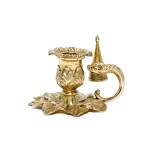
A George IV silver chamberstick, Robert Gainsford, Sheffield, 1829
No reserve
Lot Closed
November 23, 03:33 PM GMT
Estimate
500 - 700 GBP
Lot Details
Description
A George IV silver chamberstick
Robert Gainsford, Sheffield
1829
naturalistic form, modelled as leaves with a dolphin handle and removable drip-pan and extinguisher
9.5cm., 3 ¾ in. high
264gr., 8.5oz.
According to Frederick Bradbury (1 June 1864 – 26 January 1949) of the old-established Sheffield silversmiths, Thomas Bradbury & Sons Ltd., in his History of Old Sheffield Plate (Sheffield, 1912), Robert Gainsford (Robert William Gainsford, 1773 - 22 November 1852) first came to prominence about 1797 as a partner with Alexander Goodman (d. 1809) and George Fairbairn in the firm of Goodman & Co., silver platers of Sheffield. Following the dissolution of that partnership on 25 June 1808 (London Gazette, London, 9 July 1808, p. 969b), Gainsford began his own business, Gainsford & Co., 90 Eyre Street, Sheffield, otherwise Gainsford & Nicholson and then, from 1825, Gainsford, Fenton & Nicholson, the other partners being Henry Fenton and Thomas Nicholson (1779? - 19 May 1860).
Nothing is known of Henry Fenton but he may have have been related to Robert Gainsford. In fact, there is a distinct possibility that the latter's maternal grandfather was Matthew Fenton (d. 1795) of Matthew Fenton & Co., who in September 1773 entered their mark at the Sheffield Assay Office.
In 1814/15, Gainsford & Co. advertised their extensive range of 'ROMAN CATHOLIC CHURCH PLATE,' (Gainsford himself being Roman Catholic) which could be had in 'either Silver, or strong plated . . . and are sold for them at No. 114, Strand, opposite Exeter change, by Mr. ARTHUR KEATING, Jeweller, Silversmith, and Watchmaker, who in London is the only Catholic Vender [sic] of those Articles.' (Ordo Recitandi Divini Officii et Missæ Celebrandæ pro anno domini M,DCCC,XV,' London [1815], advertisement)
A bill-head for Gainsford & Nicholson, dated 1820, gives the addresses of their London and Dublin warehouses (i.e. showrooms), respectively 19 Bouverie Street, Fleet Street, J.A. Brown, agent; and 16 Eustace Street, Jas. Moore, agent; as well as details of the firm's output: 'Rich embossed Silver plate & all kinds of Plated Goods of the best quality.' (Bradbury, p. 46)
Indeed, much of Gainsford's surviving silver is characterized by the heavy use of die-stamped decoration. Bradbury (p. 45), drawing on recollections of Thomas Nicholson written in 1850, states that about 1800 'everyone was getting weary of the plain designs in both silver and plates wares [when he] introduced shells and dolphins into the gadroon mounts, followed by other decorations. This innovation completely revolutionised the then stereotyped designs and grew in intricacy and proportion to an extraordinary extent.'
